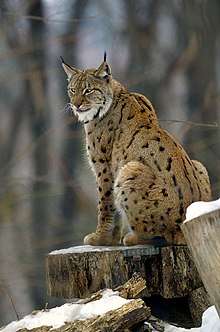Vestfold
Vestfold [ˈvɛ̂stfɔl] (![]()
Vestfold fylke | |
|---|---|
 Flag | |
 Vestfold within Norway | |
| Country | Norway |
| County | Vestfold |
| Region | Østlandet |
| County ID | NO-07 |
| Administrative centre | Tønsberg |
| Government | |
| • Governor | Per Arne Olsen Frp |
| • County mayor | Rune Hogsnes Høyre |
| Area | |
| • Total | 2,225 km2 (859 sq mi) |
| • Land | 2,201 km2 (850 sq mi) |
| Area rank | #18 in Norway, 0.71% of Norway's land area |
| Population (30 September 2019) | |
| • Total | 252,034 |
| • Rank | 10 (4.78% of country) |
| • Density | 102/km2 (260/sq mi) |
| • Change (10 years) | 8.7% |
| Demonym(s) | Vestfolding |
| Time zone | UTC+01 (CET) |
| • Summer (DST) | UTC+02 (CEST) |
| Official language form | Bokmål |
| Income (per capita) | 148,300 NOK |
| GDP (per capita) | 219,970 NOK (2001) |
| GDP national rank | 10 (3.11% of country) |
| Website | www |
Vestfold was located west of the Oslofjord, as the name indicates. It included many smaller, but well-known towns in Norway, such as Larvik, Sandefjord, Tønsberg and Horten; these towns run from Oslo in an almost constant belt of urban areas along the coast, ending in Grenland in neighbouring region Telemark. The river Numedalslågen runs through the county. Many islands are located at the coast. Vestfold is mostly dominated by lowland and is among the best agricultural areas of Norway. Winters last about three months, while pleasant summer temperatures last from May to September, with a July average high of 17 °C (63 °F).[5][6]
Vestfold was traditionally known for shipping and sailing. Sandefjord was formerly a headquarters for the Norwegian whaling fleet, and Horten used to be an important naval port. The coastal towns of Vestfold now engage in fishing and shipbuilding. Some lumbering is carried on in the interior. The area also includes some of the best farmland in Norway. Vestfold was the only county in which all municipalities had declared Bokmål to be their sole official written form of the Norwegian language.[7]
Vestfold merged with neighboring Telemark County on 1 January 2020 as part of a nationwide municipal reform. The new county name is Vestfold og Telemark.[8][9]
Etymology
Vestfold is the old name of the region which was revived in modern times. Fold was the old name of the Oslofjord, and the meaning of the name Vestfold is the region west of the Fold (see also Østfold). Before 1919, the county was called Jarlsberg og Larvik Amt. The amt was created in 1821, consisting of the two old counties of Jarlsberg and Larvik.[10] In the Viking Age, Vestfold also referred to Eiker, Drammen, Kongsberg, Lier, now in Buskerud.[11][12][13]
Vestfold Hills on Antarctica's Sørsdal Glacier is named after the county.
History
Viking history
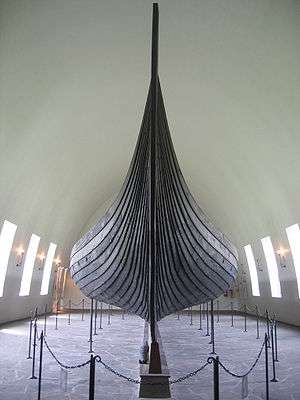
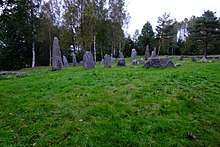
| Year | Pop. | ±% |
|---|---|---|
| 1951 | 154,670 | — |
| 1961 | 174,382 | +12.7% |
| 1971 | 175,402 | +0.6% |
| 1981 | 186,691 | +6.4% |
| 1991 | 198,354 | +6.2% |
| 2001 | 215,030 | +8.4% |
| 2011 | 233,705 | +8.7% |
| 2021? | 262,777 | +12.4% |
| 2031? | 287,496 | +9.4% |
| Source: Statistics Norway.[17] | ||
Vestfold is mentioned for the first time in a written source in 813, when Danish kings were in Vestfold to quell an uprising amongst the Fürsts.[18] There may have been as many as six political centers in Vestfold. At that time Kaupang, which was located in Tjølling near Larvik, had been functioning for decades and had a chieftain. Kaupang, which dates from the Viking Era, is believed to be the first town in Norway, although Tønsberg (which dates from ca. 900) is the oldest town in Norway still in existence. At Borre, there was a site for another chieftain. That site held chieftains for more than one hundred years prior to 813.[19]
The stone mounds at Mølen have been dated to the Viking Age.[20] The mounds at Haugar in present-day Tønsberg's town centre have been dated to the Viking period. At Farmannshaugen in Sem there seems to have been activity at the time, while activity at Oseberghaugen and Gokstadhaugen dates from a few decades later.[21]
An English source from around 890 retells the voyage of Ottar (Ottar fra Hålogaland) "from the farthest North, along Norvegr via Kaupang and Hedeby to England", where Ottar places Kaupang in the land of the Dane - danenes land.[20] Bjørn Brandlien says that "To the degree that Harald Hårfagre gathered a kingdom after the Battle of Hafrsfjord at the end of the 9th century - that especially is connected to Avaldsnes - it does not seem to have made such a great impression on Ottar".[20] Kaupang is mentioned under the name of Skiringssal (Kaupangen i Skiringssal) in Ottar's tales.[22][23]
By the 10th century, the local kings had established themselves. The king or his ombudsman resided in the old Royal Court at Sæheim i Sem, today the Jarlsberg Estate (Jarlsberg Hovedgård) in Tønsberg. The farm Haugar (from Old Norse haugr meaning hill or mound) became the seat for Haugating, the Thing for Vestfold and one of Norway's most important place for the proclamation of kings.[24] [25] The family of Harald Fairhair, who was most likely the first king of Norway, is said to have come from this area.
The Danish kings seem to have been weak in Vestfold from around the middle of the 9th century until the middle of the 10th century, but their rule was strengthened there at the end of the 10th century.[20] The Danish kings seem to have tried to control the region until the 13th century.[20]
Kings ruling some or all of Vestfold
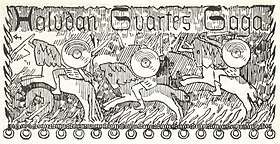
- Erik Agnarsson
- Halfdan Hvitbeinn (part of Vestfold)
- Eystein Halfdansson
- Halfdan the Mild
- Gudrød the Hunter
- Halfdan the Black, together with his brother, Olaf Gudrødsson
- Ragnvald the Mountain-High, Cousin of Harold Fairhair
- Harald Fairhair
- Bjørn Farmann
- Olaf Haraldsson Geirstadalf, brother of Bjørn
- Harald Gudrødsson Grenske, 976–987
Whaling

Whaling was an important 19th century industry in coastal cities such as Larvik, Tønsberg, and Sandefjord, which was the world centre for the world's modern whaling industry. Not only did men from Vestfold County make up practically all the crew on the Norwegian whaling fleet, but many were also involved in the whaling industry in other nations.[28] As an example, the first phase of modern Australian whaling was almost entirely based on workers from Larvik.[29] While the first whaling station in the Faroe Islands was established by Sandefjordians,[30] Larvik played a similar role for the Shetland Islands. Tønsberg initiated much of the whaling industry in Iceland and the Hebrides.[31]
The largest settlement in South Georgia and the South Sandwich Islands, Grytviken, was established by Carl Anton Larsen of Sandefjord on 16 November 1904.[32][33] Sandefjordian Nils Larsen's expeditions to Antarctica in the early 20th century led to the Norwegian annexation of Bouvet Island (1927) and Peter I Island (1929). A cove on Peter I Island is named Sandefjord Cove in honor of Nils Larsen's hometown.[34][35]
Sandefjord Harbor is now home to Southern Actor, the only whale-catcher from the Modern Whaling Epoch still to be in its original order.[36][37][38] The museum ship is owned by Sandefjord Whaling Museum, Europe's only museum dedicated to whaling.[39][40][41] Sandefjord has been named the centre of the Modern Whaling Epoch,[42] and has been nicknamed "the whaling capital of the world."[43][44][45][46]
Geography

Vestfold is Norway's smallest county, with the exception of the city-county of Oslo. It lies on the western shore of the Oslofjord. Vestfold borders with Buskerud County in the north and with Telemark County in the west. It is bordered by Skagerrak in the North Sea to both the south and east. The county has a total area of 2,157 square kilometres (833 sq mi) and has a 980 kilometres (610 mi) coastline. Vestfjellet at 634.04 metres (2,080.2 ft) is the tallest peak in the county. It is also home to 1,407 islands.[8] Nøtterøy (60 square kilometres (23 sq mi)) is the largest island in Vestfold, while Tjøme (39 square kilometres (15 sq mi)) is the second-largest island.[47][48]
There is a total of 634 freshwater lakes in Vestfold, with a total area of 79 square kilometers. Large lakes include Farris, Eikeren, Goksjø, Hallevannet, Akersvannet, and others. Vestfold makes up 0.7 percent of Norway's total land area. Ten Norwegian municipalities are larger in size than Vestfold County.[48] As an example, Kautokeino municipality in Finnmark County is over four times larger than Vestfold County. The county of Finnmark is 22 times larger than Vestfold.
Geology
.jpg)

The county's soft soil is composed of varieties of moraine and sedimentary soils. The Ice Age left large parts of Vestfold below sea level, and the most cultivated soil can be found on the marine terraces. Marine clay and sand cover most of the lower lying country in the south-west and north. The Vestfold moraine, a continuation of the Østfold moraine at Moss, is an ice-formed formation which stretches as a cohesive gravel ridge through the county, from Horten in the east to Mølen in the south.[48]
Preserved areas
Færder National Park was the county's first national park when the decision was formalized by King Harald V on 23 August 2013.[8][49] The visitor center is at World's End, and was officially opened by Queen Sonja on 26 June 2015.[50][51] The national park lies in Nøtterøy- and Tjøme municipalities, and is made up of 325 square kilometres (125 sq mi) of ocean and 15 square kilometres (5.8 sq mi) of land. It stretches from Ormøy in the north to Færder Lighthouse in the south.[51] It is one of two marine national parks in Norway, and is made up of coast, skerries, islands and sea bed.[52]
Mølen in Larvik is home to Norway's largest stone beach[53] and is an ancient burial site consisting of 230 cairns, some exceeding 35 metres (115 ft) in diameter. Excavations have dated the rock piles to about 250 A.D.[54][55] It was the first UNESCO Global Geopark in the Nordics when established in 2008.[56][57] Mølen is one of Larvik's most popular tourist attractions. It is home to over a hundred species of rock, including Norway's national stone, Larvikite, which is named from the area. It is a crucially important seabird habitat, where over 316 species of bird have been recorded.[58][59]
Municipalities

Vestfold County has experienced a large reduction in number of municipalities. As of 1949, the county was home to 19 rural municipalities and seven city municipalities. There were 14 municipalities as of 2016, but the number will decrease to 8 by 1 January 2020.[60]
As of 1 January 2017 the number of municipalities in Vestfold County was reduced from 14 to 12.
As of 1 January 2018 the number of municipalities in Vestfold County was reduced from 12 to 9.
- Andebu (merged into Sandefjord on 1 January 2017)
- Hof (merged into Holmestrand on 1 January 2018)
- Holmestrand (added Hof on 1 January 2018)
- Horten
- Lardal (merged into Larvik on 1 January 2018)
- Larvik (added Lardal on 1 January 2018)
- Nøtterøy (merged with Tjøme on 1 January 2018 to form the new municipality of Færder)
- Re
- Sande
- Sandefjord (added Andebu and Stokke on 1 January 2017)
- Stokke (merged into Sandefjord on 1 January 2017)
- Svelvik
- Tjøme (merged with Nøtterøy on 1 January 2018 to form the new municipality of Færder)
- Tønsberg
Cities
Parishes
- Andebu
- Arnadal (Arendal)
- Berg
- Borre
- Botne
- Brunlanes
- Fon
- Fredricksværn, see Stavern
- Hedrum
- Hem
- Hillestad
- Hof
- Holmestrand
- Horten
- Hvarnes
- Høyjord
- Kjose
- Kodal
- Konnerud
- Kvelde
- Langestrand
- Lardal
- Larvik
- Nykirke
- Nøtterøy
- Ramnes
- Sandar
- Sande
- Sandefjord
- Sandeherred, see Sandar
- Sankt Laurentii
- Sem
- Skjee
- Skoger
- Slagen
- Stavern
- Stokke
- Strømm (Strømmen)
- Strømsgodset
- Styrvoll
- Svarstad
- Svelvik
- Tanum
- Tjølling
- Tjøme
- Tønsberg
- Undrumsdal
- Valløy
- Vassås
- Vivestad
- Vor Frue (Maria)
- Våle
- Åsgårdstrand
- Larvik Branch (LDS, early-1927)
- Tønsberg Branch (LDS, early-1951)
- Larvik (Katolske Apostoliske, 1888-1963)
Villages
- Andebu
- Barkåker
- Berger
- Bergsåsen
- Bjerkøya
- Bjørnevåg
- Borgheim
- Borre
- Brekkeåsen
- Buerstad
- Duken
- Eidsfoss
- Eik
- Eikeberg
- Fevang
- Fokserød
- Fon
- Freberg
- Føynland
- Gjone
- Glomstein
- Gretteåsen
- Grimestad
- Gullhaug
- Hafallen
- Helgeroa
- Hem
- Hof
- Hulebakk
- Husvik
- Husøy
- Hvasser
- Høyjord
- Hårkollen
- Kaupang
- Kjose
- Kjøpmannskjær
- Klever
- Kodal
- Kvelde
- Lahelle
- Linnestad
- Melsomvik
- Nesbrygga
- Nesbygda
- Nykirke
- Ormelet
- Oterbekk
- Ramnes
- Revetal
- Rånerudåsen
- Råstad
- Sande
- Selvik
- Sem
- Skallestad
- Skinmo
- Skjerve
- Skoppum
- Solløkka
- Solvang
- Stavern
- Stokke
- Storevar
- Strand
- Strengsdal
- Sundbyfoss
- Sundene
- Svarstad
- Svelvik
- Svinevoll
- Teie
- Tenvik
- Torød
- Ula
- Unneberg
- Valberg
- Vassås
- Vear
- Veierland
- Verdens Ende
- Verningen
- Vestskogen
- Vollen
- Årøysund
- Åsgårdstrand
Former Municipalities
Political strength
Results from parliamentary elections in Vestfold County since 1973:[61][62]
Bold letters represent the alliances (Leftwing Ap+SV. Centre KrF+V+Sp. Rightwing H+Frp). M = Number of elected parliamentarians.
| Year | Ap | SV | Total | M | KrF | V | Sp | Total | M | H | Frp | Total | M |
|---|---|---|---|---|---|---|---|---|---|---|---|---|---|
| 1973 | 33,8 | 8,9 | 42,7 | 3 | 10,3 | 3,0 | 7,6 | 20,9 | 2 | 26,5 | 6,6 | 33,1 | 2 |
| 1977 | 39,8 | 2,6 | 42,4 | 3 | 10,2 | 2,8 | 7,2 | 20,2 | 1 | 33,7 | 2,0 | 35,7 | 3 |
| 1981 | 33,9 | 2,9 | 36,8 | 3 | 8,2 | 3,2 | 4,2 | 15,6 | 0 | 41,9 | 4,7 | 46,6 | 4 |
| 1985 | 35,4 | 4,0 | 39,4 | 3 | 7,0 | 2,7 | 4,4 | 14,1 | 1 | 40,9 | 4,8 | 45,7 | 3 |
| 1989 | 30,1 | 8,3 | 38,4 | 4 | 7,1 | 2,7 | 4,5 | 14,3 | 0 | 28,9 | 16,5 | 45,4 | 3 |
| 1993 | 35,4 | 6,5 | 41,9 | 3 | 6,9 | 2,7 | 13,2 | 22,8 | 1 | 23,1 | 10,3 | 33,2 | 3 |
| 1997 | 33,5 | 5,3 | 38,8 | 3 | 12,5 | 3,2 | 5,6 | 21,3 | 1 | 18,1 | 20,1 | 38,2 | 3 |
| 2001 | 21,6 | 11,6 | 33,2 | 3 | 11,0 | 2,8 | 3,3 | 17,1 | 1 | 25,5 | 18,7 | 44,2 | 4 |
| 2005 | 30,2 | 8,4 | 38,6 | 4 | 6,0 | 5,0 | 3,6 | 14,6 | 0 | 15,3 | 29,3 | 44,6 | 3 |
| 2009 | 33,7 | 6,5 | 40,2 | 4 | 4,7 | 3,0 | 3,2 | 10,9 | 0 | 19,6 | 27,2 | 46,8 | 3 |
| 2013 | 29,6 | 3,8 | 33,4 | 2 | 4,9 | 4,5 | 3,0 | 12,4 | 1 | 30,0 | 19,5 | 49,5 | 4 |
| 2017 | 28,0 | 5,0 | 33,0 | 2 | 3,7 | 3,8 | 6,3 | 13,8 | 1 | 30,1 | 16,9 | 47,0 | 4 |
Demographics
According to Statistics Norway, Vestfold County is home to 244,967 residents as of 1 January 2016.[65] Immigrants made up 11.9 percent of the population in 2017.[66] Most immigrants were from Poland (4,287 people), followed by Lithuania (2,794) and Iraq (1,549).[66] Despite of its small size, Vestfold has the third-highest population density in Norway.[8] However, the population density may still be considered low; as an example, the population density of the Netherlands is four times higher than that of Vestfold County.[48]
Sandefjord is the most populous city of Vestfold County;[36] one in four people from Vestfold are from Sandefjord, or 25.2 percent of the county population.[67]
Economy
Traditional industries in Vestfold have included whaling and ship building. For over 50 years in the 19th century, Sandefjord and partially Tønsberg functioned as the world centre for the whaling industry.[28] However, whaling ended in the 1960s and the ship building industry has gradually reduced since the 1980s. Information technology is currently a growing industry, and the county is home to large web shops such as Komplett, MPX.no and netshop.no. 18.9 percent of the county's total area is used for agriculture, the highest percentage of any county in Norway. 70% of agricultural lands are used for the cultivation of grains.[8] Vestfold's farming area makes up five percent of Norway's cultivated areas. However, by area, Vestfold only makes up 0.7 percent of Norway's land area.[48]
Vestfold has Norway's most expensive vacation homes. Sandefjord had Norway's most expensive vacation homes in 2012, while Tjøme had the most expensive homes as of 2010.[71][72] General property values appreciated 28.3 percent between 2010–2015.[73]
Tourism

Summer tourism is an important industry in Vestfold, particularly in coastal communities such as Sandefjord, Tjøme and Stavern. Coastal cities also have large numbers of vacation homes. There were 534,724 hotel stays in 2015, where the purpose was vacationing for 236,895. Most international tourists were from the United Kingdom, Sweden, and Denmark. There were 781,459 stays at rental cabins or campgrounds in 2015.[8] Consequentially, the population increases drastically during summer months in municipalities such as Sandefjord,[76] Tjøme, and elsewhere. The population at Tjøme goes from 4,500 to around 50,000 each summer.[77] The population of islands such as Tjøme often quadruple during summer,[78] while summer communities as Stavern often sees a doubling or tripling.[79] Tjøme Island is home to nearly as many vacation homes as residential homes.[80]
While Tjøme has the nickname Sommerøya ("the Summer Island"),[81][82] Sandefjord is nicknamed Badebyen ("the Bathing City") due to its many beaches and former spas.[83] Sandefjord is known for its many great beaches,[84][85] and it is primarily known as a summer resort community.[86][87] It first became a bathing destination when sulphur was discovered in 1837.[88][36] The city gained further recognition when Sandefjord Sulfur Spa and Resort (Kurbadet) was established in 1837. The bath was one of the most visited in Europe during the late 19th century.[89]
Vestfold's most visited tourist attractions include Borre mound cemetery, the largest burial site in Northern Europe, as well as numerous sites along the coast. Architectural sites include the villages of Åsgårdstrand, Karljohansvern in Horten, and Fredriksvern in Stavern. Other important attractions are Sandefjord Whaling Museum, Mølen Geopark in Larvik, as well as Tønsberg Fortress (Slottsfjellet) in Tønsberg.[8]
Largest companies
Largest companies in Vestfold County based on operating income in 2015:[90]
| No. | Company | Operating income in 2015 (in NOK) |
|---|---|---|
| 1 | Jotun A/S | 16 844 327 |
| 2 | Komplett AS | 7 256 700 |
| 3 | Kongsberg Maritime AS | 6 957 840 |
| 4 | Asko Vestfold Telemark AS | 4 617 791 |
| 5 | Sykehuset i Vestfold HF | 4 595 010 |
Culture

Vestfold is the county in Norway with the most traces from the Viking Age.[92][93][94] Examples include the Oseberg- and Gokstad Burial Mounds. While the Oseberg Ship was discovered in Tønsberg, the Gokstad Ship was discovered in Sandefjord. The Gokstad Ship is Norway's largest preserved Viking ship. Both ships are now located at the Viking Ship Museum in Oslo. Additional burial mounds are found at Borre mound cemetery and Mølen, an UNESCO Global Geopark. Borre mound cemetery is home to Northern Europe's largest burial mound site from Viking Age.[8]
Vestfold is home to 21 churches dating to medieval times. It is also home to one stave church, Høyjord Stave Church in Andebu (Sandefjord). Nearby Andebu Church also has Norway's oldest parish register, dating to 1623.[36] The city of Sandefjord proper is home to Europe's only museum dedicated to whaling, Sandefjord Museum in the city centre.[95][96][97] This museum also owns Southern Actor, a whale-catcher turned museum ship. Southern Actor is the only whale-catcher from the Modern Whaling Epoch still to be in its original working order.[37][38] Also at Sandefjord Harbor is the Harbour Chapel (Bryggekapellet), which is the only floating church in Norway[98] and most likely Europe,[99] perhaps the only floating church in the world.[100]
The city of Tønsberg is Norway's oldest city, most likely founded in year 871.[78][101][102] Tønsberg is home to Tønsberg Fortress, which is Scandinavia's largest ruin site. It includes ruins from Castrum Tunsbergis, Norway's largest castle in the 13th century. An outdoor music festival is held at Tønsberg Fortress every July.[103][78] Ruins of a German fortress can be seen at Folehavna Fort on West Island, Sandefjord.[104]
Transportation
The Vestfold Line is a railway line that runs from Drammen, through a number of towns in Vestfold and ending in the town of Skien in Telemark. European route E18 runs through the county roughly parallel to the railway.[48]
There are two international ferry connections, both operated by Color Line. Larvik is connected to the Danish town Hirtshals, the other route is between Sandefjord and Strømstad in Sweden. Fjord Line is also a ferry operator between Sandefjord and Strømstad. In addition there is a domestic route connecting Horten and Moss.
Sandefjord Airport Torp is one of Norway's largest airports.[107] Only Bergen- and Oslo Airports have more international flights than Torp Airport.[108] Despite being located 74 miles south of Oslo, Torp is sometimes called Oslo Airport Torp. It is reached with a free shuttle bus from Sandefjord Airport Station on Vestfoldbanen. Torp is regional hub for low-cost carrier Norwegian, as well as low-cost carriers Ryanair and WizzAir also operate from the airport.[109] Torp offers direct routes to over 30 international and domestic destinations,[110] including daily flights to European cities such as London and Amsterdam.[111]
Points of interest
Larvik


- Bøkeskogen, world's northernmost beech tree forest.[112][113][114]
- Kaupang, home to remains for the oldest Nordic town yet discovered. The remains are from one of Scandinavia's earliest urban sites, established in year 800 A.D.[115][116]
- Mølen, Scandinavia's first UNESCO Global Geopark.
- Nevlunghavn and Helgeroa, adjacent coastal villages.
- Larvik Museum
- Fritzøehus, largest privately owned estate in Norway.[117][118][119]
- Stavern, small coastal town, home of Citadell Island
- Fredriksvern, Norway's main naval base from the mid 1750s until 1864.[79]
- Minnehallen (Hall of Remembrance), largest monument in Vestfold.[120]
Horten
- Borre National Park, largest burial mound site in Northern Europe.[8]
- Løvøy Chapel
- Royal Norwegian Navy Museum
- Preus Museum
- Borre Church, romanesque medieval church constructed in the 1100s.[121]
- Tordenskioldeika
- Åsgårdstrand, oceanside resort town.[122][123]
- Borre Golfbane
Tønsberg and Færder
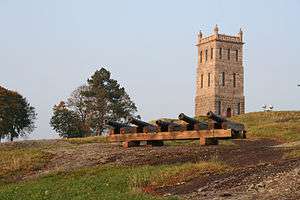
- Tønsberg Fortress, largest ruin park in the Nordic Countries.[125]
- Oseberg Mound, site of the discovery of the Oseberg Ship
- Haugar
- Tønsberg Cathedral
- Sem Church
- Slottsfjellmuseet
- Nordbyen
- World's End, southernmost point at Tjøme.[126]
- Herkelås
- Tjøme Church
- Færder National Park, first National Park in Vestfold.[8][49]
Sandefjord
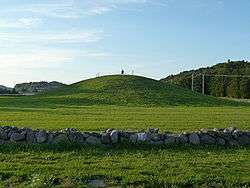
- Sandefjord Museum (the Whaling Museum), Europe's only museum dedicated to whaling.[39][40][41]
- Southern Actor, only whale-catcher from the Modern Whaling Epoch still to be in its original working order.[37][38][36]
- Gokstad Mound, site of the discovery of the 9th-century Gokstad Ship.
- Gaia, replica of the Gokstad Ship docked at Museum's Wharf.
- Sandar Church, built on ruins of a 13th-century medieval stone church. Present church was erected in 1792.
- Whaler's Monument, rotating bronze monument erected in honor of pioneering whalers.
- Sandefjord Church
- Istrehågan, ancient burial ground which dates to the Roman Iron Age around 1500-500 BCE.[16]
- Kurbadet, former resort spa and one of Europe's most visited baths in the late 19th century.[89]
- Folehavna Fort, ruins from a German fortress erected in 1941 during the German occupation of Norway.[104]
- Høyjord Stave Church, the only stave church left in Vestfold County.[36]
- Langeby, popular bathing beach at West Island.
- Goksjø, third-largest lake in Vestfold County.
Archaeological sites
.jpg)
Istrehågan
Istrehågan is an ancient burial ground which dates to the Roman Iron Age around 1500-500 BCE.[16] It is located at Jåberg in Tjølling, on the border between Sandefjord and Larvik.[131][128] The rock settings at Istrehågan resemble a ship. It is 24 metres (79 ft) long, and 9 metres (30 ft) meters broad. Archaeological excavations made in 1959-61 uncovered remains of bones, bear claws, pottery shards, a brooch, and more.[132] At Haugen farm on the Sandefjord side is Vestfold County's largest collection of petroglyphs.[133]
Borre National Park

At Borrehaugene near Borrre there are 9 large mounds and around 30 smaller ones.[20][134] It is the largest burial mound site in Northern Europe.[8]
Borre mound cemetery most likely contains graves belonging to kings of the Yngling dynasty. It is mentioned in the poem Ynglingatal as the burial site of one of two kings belonging to the royal dynasty of the Ynglingas.[135]
Kaupang
Kaupang in Skiringssal (Larvik) is home to remains from the oldest Nordic town yet discovered.[116] It was a trade centre established around year 800, making it one of Scandinavia's earliest urban sites. The settlement was abandoned in the mid-10th century.[115] It is located in Kaupang Bay in Viksfjord, Larvik. Archeological finds include melting pots, jewelry parts, casting moulds and casting models.[136] Most of Kaupang remains not excavated.[137] There are replicas of Viking homes at Kaupang today, giving insight to how homes were constructed during the Viking Age.[138][139]
Oseberg Burial Mound
.jpg)
Oseberg Mound is located in Tønsberg and is where the Oseberg Ship was discovered. The ship, which dates to 834 A.D., had a length of 22 metres (72 ft). Two female skeletons were found in the ship's burial chamber.[140]
Viking burial site at Gulli
Gulli, outside Tønsberg, was the site of an archaeological excavation during the period from 2003 to 2004, prior to asphalt being laid for constructing the new E18 (road).[141] There were 60 graves - 20 of those were preserved to a degree that [authorities decided] permitted examinations.[141] "Perhaps the most spectacular [item] was a høvre" - used with a horse's harness. "There are few of those in Norway - one in Trøndelag and a gilded one found in Borre".[141] The artifacts are on display at the Midgard Historical Centre in Borre.[142] [143]
Fevang
19th century archeologists were struck by the many burial mounds and artifacts discovered at Fevang near Torp Airport in Sandefjord. Local farmers had discovered various artifacts in the 19th- and early 20th centuries. Archeologist Nicolay Nicolaysen traveled to Fevang and concluded that Fevang was home to an array of ancient burial mounds. Nicolaysen further discovered that Fevang had been an active graveyard for over 1,000 years - since year 0 A.D. until the first Christian cemeteries were established. Among the artifacts discovered were a gold jewel named Berlokk, which was retrieved in a woman's grave along with two gold beads, two blue glass beads, a hairpin, ceramic, burnt bones, and two clips of bronze. Her tomb is dated to the Old Iron Age, around 0-400 A.D.[144][145]
Gokstad Mound
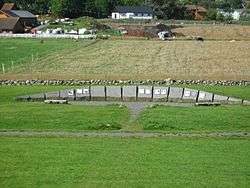

Gokstad Mound in Sandefjord was where the Gokstad Ship was excavated by Nicolay Nicolaysen in 1880.[146] The skeleton of a man was found in the ship, long believed to be Olaf Geirstad-Alf, former king of Vestfold and half-brother of Halfdan the Black, the father of Harald Fairhair, Norway's first king. However, recent discoveries have increased uncertainty and it therefore remains unknown what chieftain was buried at Gokstad.[26][147]
The ship, which is the largest found in Norway, is currently located at the Viking Ship Museum in Oslo. The 23.8 metres (78 ft) ship was buried along with numerous gifts, including weapons, jewels, a gaming board, fish-hooks, 64 shields, six beds, three smaller boats and kitchen utensils. Twelve horses, eight dogs, two goshawks and two peacocks were also discovered in the grave.[148][149]
Interpretive signs have been put up at the mound and Gaia, an exact replica of the Gokstad Ship, can be seen on Museum's Wharf at Sandefjord Harbor.[150]
Mølen

The Old Norse word Mol translates to cairns, a site often used by ancient peoples to mark a burial site. Mølen, which is Norway's largest stone beach, is home to 230 cairns, which have been built over ages. Some cairns have been dated to 250 A.D.[54][59] The isthmus of Mølen is home to stone piles, grave mounds, and stone settings, which are all part of a protected historic site. The last Ice Age pushed large amounts of gravel and stones ahead of it, and deposited it as a moraine through all of Vestfold, known as Vestfoldraet. Raet meets the ocean at Mølen, where the moraine sinks into the sea. Its encounter with the Skagerrak ocean waves has uncovered and polished the huge round stone floor for centuries.[151]
Bøkeskogen
Besides being the largest birch tree forest in Norway, and the most northernmost birch tree forest in the world,[114] Bøkeskogen is also an important archeological area. 83-90 burial mounds have been discovered in the forest. Some of these include the largest burial grounds from the Pre-Roman Iron Age in Vestfold County.[152]
Recreation
At least 238 kilometers of coastal hiking trails can be found in Vestfold County, from Larvik in the south to Svelvik in the north.[153] Hiking trails are found throughout the county, including at World's End in Færder National Park. Furthermore, there is a 35 km (22 mi.) marked trail between the towns of Stavern and Helgeroa. Mølen, Kjærrafossen and Bøkeskogen are also home to various trails. Tønsberg Barrel, an old beacon dated to Sverris saga in the Middle Ages,[154] sits at Yxnøy on Sandefjord's East Island. West Island is home to Folehavna Fort and additional trails.[155] Combined, the trails on Sandefjord's East- and West Islands are 45 km (28 mi.), and a part of the international North Sea Trail.[156][157] Bøkeskogen in Larvik is home to various trails, varying from 2.6 km (1.6 mi.) to 10 km (6.2 mi.) in length.[158]
Fauna
Vestfold's fauna includes species such as the White-tailed eagle, Roe deer, Moose, European hedgehog, Eurasian eagle-owl, Mountain hare, European badger, European pine marten, and Norway lemming. Rare observations of Gray wolf, European lynx,[162][163] and Brown bear do occur.[164] A wolf shot in Lardal in 2013 was the first wolf killed in the county in over 100 years.[165] Between 700-800 moose are annually hunted in Vestfold.[8] Larvik has one of the highest numbers of moose in Norway.[152]
The Harbor seal is the most commonly observed species of seal in Vestfold, and it was estimated to be at minimum 183 seals in Vestfold as of August 2014.[166][167] Dolphins are uncommon, however, a Common bottlenose dolphin was observed by Nøtterøy in 2014,[168] and a Striped dolphin was observed the same summer at Helgeroa in Larvik.[169]
Common European Viper is the only venomous snake found in Norway.[170] There are two non-venomous snake species in Vestfold County: European grass snake and European smooth snake.[171]
Vestfold has a rich avifauna: over 130 bird species have been observed in Svelvik,[172] while Mølen in Larvik has the national record of 320 species.[173]
Wildlife refuge
Saltstein is part of a protected habitat for birds.[174] From 2014 surfing was permitted off Saltstein.[174]
Besides being an UNESCO Global Geopark, Mølen in Larvik is a habitat for a variety of rare bird species.[175] Mølen became a protected sanctuary for birds in 1970.[57] 320 species of birds have been recorded at Mølen, more species than at any other site in Norway.[173]
Wildlife preserves include Melsom- and Hemskilen Wildlife Preserves. Hemskilen Wildlife Preserve lies on the Larvik-Sandefjord border and is an important habitat for shorebirds, geese, and Passerines.[176] Melsom Plant- and Wildlife Preserve in Sandefjord is home to various older oaks, some of them home to as many as 1,500 different species of insects.[177] Marøyskjæra Bird Preserve consists of two skerries west of Natholmen Island, which have been important nesting areas for Common tern and Common gull since the 1980s. Over 500 seagulls hatched on the islets in the 1990s.[178][179]
In popular culture
Although not filmed in Vestfold, the City of Tønsberg appears in the films Thor (2011) and also in Captain America: The First Avenger (2011), and in Avengers: Endgame[180]
Some films shot in Vestfold include:
- Norway (2018), movie based on the 2011 Norway attacks, filmed in Tønsberg and Nøtterøy.[181][182]
- Olsenbanden tar gull (1972), filmed in Stavern (Larvik) and Sande in Vestfold.[183][184]
- Baadshah (1999), Tønsberg[185]
- Christmas Blood ("Juleblod") (2017), Tønsberg and Sandefjord.[186]
- Wisting (2018– ), Larvik and Sandefjord.[187]
- Nonni and Manni (1988–89), Horten.[188]
- Head Above Water (1993), filmed at East Island in Sandefjord.[189][190]
- Deadline Torp (2005), movie based on the 1994 Torp hostage crisis, filmed in Sandefjord and Larvik.[191]
- Valfångare (1939), Sandefjord.[192]
- Den starkaste (1929), Sandefjord.[193]
Gallery
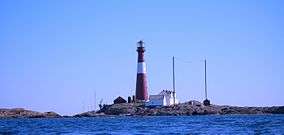
 Borre National Park in Horten
Borre National Park in Horten The Oseberg Ship was discovered in Tønsberg.
The Oseberg Ship was discovered in Tønsberg. Town centre in Stavern
Town centre in Stavern Citadellet, 19th-century fortress in Stavern
Citadellet, 19th-century fortress in Stavern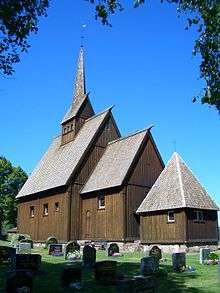
References
- Norum, Roger (2011). Frommer's Norway. Frommer's. Page 4. ISBN 978-0470972427.
- Evensberget, Snorre (2012). DK Eyewitness Travel Guide: Norway. Penguin. Page 230. ISBN 9780756693305.
- Ham, Anthony and Stuart Butler (2015). Lonely Planet Norway. Lonely Planet. Page 87. ISBN 978-1742202075.
- "Vestfold". Lokalhistoriewiki. Archived from the original on 8 December 2015. Retrieved 29 November 2015.
- institutt, NRK og Meteorologisk. "Yr – Climate statistics Tønsberg (Vestfold)". yr.no. Archived from the original on 13 March 2016.
- "Numedalslågen". Lokalhistoriewiki. Archived from the original on 8 December 2015. Retrieved 29 November 2015.
- Vestfold County (Vestfold University College0 Archived 22 October 2010 at the Wayback Machine
- Lundbo, Sten (3 June 2019). "Vestfold". Archived from the original on 12 June 2018. Retrieved 6 June 2019 – via Store norske leksikon.
- "Nå er Telemark og Vestfold slått sammen". www.ta.no. 8 June 2017.
- "County Vestfold". gonorway.no. Archived from the original on 4 March 2016.
- Munch, Peter Andreas (1849). Historisk-geographisk beskrivelse over kongeriget Norge (Noregsveldi) i middelalderen. W. Gram. pp. 168–179.
- Vol. XIII: A History Of Norway And The Passion And Miracles of the Blessed Óláfr Archived 21 February 2016 at the Wayback Machine Anthony Faulkes and Richard Perkins (Viking Society for Northern Research), p. 128)
- Vestfold - gammelt navn Archived 18 October 2016 at the Wayback Machine, snl.no
- Sødal, Hedda. "Fant 1000 år gammel fot". Aftenposten.
- Martin, Will. "Sharks, otters, and a man playing rugby: These are the 6 most beautiful banknotes in the world right now". Business Insider. Archived from the original on 4 July 2019. Retrieved 6 June 2019.
- "Rock carvings and standing stones at Haugen Farm". www.visitvestfold.com.
- "Projected population - Statistics Norway". Archived from the original on 26 May 2012. Retrieved 6 June 2019.
- Bjørn Brandlien (5 October 2015). "Var Vestfold Norges vugge?". Klassekampen. p. 10.
- "Tønsberg - the oldest town in Norway". www.visitnorway.com. Archived from the original on 22 May 2014.
- Bjørn Brandlien (5 October 2015). "Var Vestfold Norges vugge?". Klassekampen. p. 11.
- "Haugar (Tønsberg)". Lokalhistoriewiki. Archived from the original on 15 September 2015. Retrieved 29 November 2015.
- "Vestvågøy Theme 9 of Travels in Time". www.travels-in-time.net. Archived from the original on 8 July 2015.
- "Ottar". Norsk biografisk leksikon. Archived from the original on 8 December 2015. Retrieved 29 November 2015.
- Terje Bratberg. "Jarlsberg". Store norske leksikon. Archived from the original on 8 December 2015. Retrieved 25 November 2015.
- Geir Thorsnæs. "Haugar – Tønsberg". Store norske leksikon. Archived from the original on 8 December 2015. Retrieved 25 November 2015.
- "The Gokstad mound". www.visitnorway.com. Archived from the original on 12 June 2018. Retrieved 10 June 2018.
- Børresen, Svein E. (2004). Vestfoldboka: en reise i kultur og natur. Skagerrak forl. Page 46. ISBN 9788292284070.
- Tønnessen, Johan Nicolay and Arne Odd Johnsen (1982). The History of Modern Whaling. University of California Press. Page 25. ISBN 9780520039735.
- Tønnessen, Johan Nicolay and Arne Odd Johnsen (1982). The History of Modern Whaling. University of California Press. Page 222. ISBN 9780520039735.
- Joensen, Jóan Pauli (2009). Pilot Whaling in the Faroe Islands: History, Ethnography, Symbol. Faroe University Press. Page 225. ISBN 9789991865256.
- Tønnessen, Johan Nicolay and Arne Odd Johnsen (1982). The History of Modern Whaling. University of California Press. Page 84. ISBN 9780520039735.
- Headland, Robert (1992). The Island of South Georgia. CUP Archive. Page 130. ISBN 9780521424745.
- "Archived copy". Archived from the original on 12 June 2018. Retrieved 16 June 2018.CS1 maint: archived copy as title (link)
- "Andre «Norvegia»- ekspedisjon med kaptein Nils Larsen og dr. Ole Olstad besøkte Bouvetøya og gjennomførte den første landingen på Peter I Øy 2. februar 1929. Øya ble annektert for Norge, offisielt anerkjent ved kgl. res. 1. mai 1931. -". www.polarhistorie.no. Archived from the original on 8 February 2019. Retrieved 16 June 2018.
- "Lars Christensen -". Archived from the original on 21 December 2018. Retrieved 16 June 2018.
- Lundbo, Sten (26 April 2019). "Sandefjord". Archived from the original on 11 May 2019. Retrieved 6 June 2019 – via Store norske leksikon.
- "The Whale catcher Southern Actor". www.visitvestfold.com.
- "The Whale catcher Southern Actor". www.visitnorway.com. Archived from the original on 12 June 2018. Retrieved 10 June 2018.
- Philpott, Don (1991). Visitor's Guide: Norway. Moorland. Page 76. ISBN 9780861904242.
- "The Whaling Museum". Visitvestfold.com. Archived from the original on 9 December 2017. Retrieved 28 December 2017.
- "Hvalfangstmuseet". Hvalfangstmuseet.no. Archived from the original on 26 January 2018. Retrieved 28 December 2017.
- Holskjær, Lars (2017). Kamper uten tall. Forlagshuset i Vestfold. Page 8. ISBN 9788293407294.
- Engel, Lyle Kenyon (1963). Scandinavia: A Simon & Schuster Travel Guide. Cornerstone Library. Page 145.
- Ryder, Simon and Cameron Duffy (2018). Insight Guides Norway. Insight Guides. Page 163. ISBN 978-1786717580.
- Alspaugh, Emmanuelle (2006). Fodor's Norway. Fodor's Travel Publications. Page 73. ISBN 9781400016143.
- Bertelsen, Hans Kristian (1985). Sandefjord: A modern city with vast potential. Grafisk Studio. Page 81. ISBN 82-90636-00-8.
- Lundbo, Sten (10 January 2018). "Tjøme". Archived from the original on 14 May 2019. Retrieved 6 June 2019 – via Store norske leksikon.
- Bertelsen, Hans Kristian (1998). Bli kjent med Vestfold / Become acquainted with Vestfold. Stavanger Offset AS. Page 191. ISBN 9788290636017.
- Ryland, Julie. "This is Norway's new national park". The Norway Post. Archived from the original on 12 June 2018. Retrieved 10 June 2018.
- "Visitor Center Færder National Park". www.visitnorway.com.
- Ryvarden, Leif; Lundbo, Sten; Askheim, Svein (6 November 2018). "Færder nasjonalpark". Archived from the original on 24 May 2019. Retrieved 6 June 2019 – via Store norske leksikon.
- "Færder Nasjonalpark – Come closer Go Færder". ferdernasjonalpark.no. Archived from the original on 12 June 2018. Retrieved 10 June 2018.
- "Mølen | The Coast, Norway The Coast". www.lonelyplanet.com.
- "Mølen". Atlas Obscura. Archived from the original on 12 June 2018. Retrieved 6 June 2019.
- "Mølen". www.gonorway.com. Archived from the original on 12 June 2018. Retrieved 11 June 2018.
- "Åpnet Geopark på Mølen og i Lardal". www.op.no. 16 June 2008.
- "MØLEN". VESTFOLD GUIDE. Archived from the original on 12 June 2018. Retrieved 11 June 2018.
- https://issuu.com/visitvestfold/docs/visit_larvik_2018-2019_web%5B%5D (Page 26).
- "Mølen". www.visitvestfold.com.
- Larsen, Erlend (2016). Tre kommuner blir til én: Suksesskriteriene bak nye Sandefjord. E-forl. Page 27. ISBN 9788293057277.
- "Publikasjoner fra Statistisk sentralbyrå". www.ssb.no. Archived from the original on 31 July 2019. Retrieved 6 June 2019.
- "Norwegian Directorate of Elections: Results in 2017 in Vestfold County". Archived from the original on 25 October 2017. Retrieved 10 June 2018.
- "Statistikkbanken". Archived from the original on 16 July 2012. Retrieved 11 October 2010.
- "Statistics Norway - Members of religious and life stance communities outside the Church of Norway, by religion/life stance. County. 2006-2010". Archived from the original on 2 November 2011.
- "Mannsoverskotet auka òg i 2015". ssb.no. Archived from the original on 12 June 2018. Retrieved 10 June 2018.
- "Statistikk". IMDi. Archived from the original on 11 April 2019. Retrieved 10 June 2018.
- "Nå teller vi 62.622 innbyggere". www.sb.no. 30 April 2018.
- C. Gopalkrishnan (2016). The Entrepreneur's Choice: Cases on Family Business in India. Routledge. Page 243. ISBN 9781134906598.
- "Archived copy". Archived from the original on 12 June 2018. Retrieved 10 June 2018.CS1 maint: archived copy as title (link)
- "Jotun suffers drop in profit". TradeWinds | Latest shipping and maritime news. 4 June 2018. Archived from the original on 12 June 2018. Retrieved 6 June 2019.
- "Norges dyreste hytteområde har en gjennomsnittpris på 7,1 millioner kroner". www.abcnyheter.no. 27 December 2012.
- "Eiendom Norge". eiendomnorge.no. Archived from the original on 7 June 2018. Retrieved 10 June 2018.
- Hoemsnes, Anita (6 May 2015). "Her har boligprisene steget mest - og minst de siste årene". www.dn.no.
- Lund, Arild and Charlotte Jørgensen (2001). Larvik. Capella Media. Page 67. ISBN 978-8299606912.
- Bertelsen, Hans Kristian (1998). Bli kjent med Vestfold / Become acquainted with Vestfold. Stavanger Offset AS. Page 48. ISBN 9788290636017.
- Jøranlid, Marianne (1996). 40 trivelige turer i Sandefjord og omegn. Vett Viten. Page 27. ISBN 9788241202841.
- "VISIT TJØME". VISIT TJØME. Archived from the original on 12 June 2018. Retrieved 11 June 2018.
- "Tønsberg - the oldest town in Norway". www.visitnorway.com. Archived from the original on 22 May 2014. Retrieved 10 June 2018.
- Evensberget, Snorre (2014). DK Eyewitness Travel Guide: Norway. Penguin. Page 129. ISBN 9781465432469.
- "Fare for lokalpolitisk havari i nye Færder kommune?". www.tb.no. 7 February 2017.
- "VISIT TJØME — TJØME". VISIT TJØME. Archived from the original on 12 June 2018. Retrieved 11 June 2018.
- "Kliner til på kyssebenken". www.tb.no. 5 August 2011.
- Alspaugh, Emmanuelle (2006). Fodor's Norway. Fodor's Travel Publications. Pages F-7 and 73. ISBN 9781400016143.
- McKay, D. (2004). Fodor's Scandinavia. Fodor's Travel Publications. Page 398. ISBN 9781400016426.
- Alspaugh, Emmanuelle (2006). Fodor's Norway. Fodor's Travel Publications. Page 74. ISBN 9781400016143.
- Berman, Martha (1995). Fielding's Scandinavia. Fielding Worldwide. Page 240. ISBN 9781569520499.
- "Archived copy". Archived from the original on 18 April 2018. Retrieved 16 December 2018.CS1 maint: archived copy as title (link)
- Ebbesen, Jorgen Tandberg (2018). The Sulphureous Bath at Sandefjord in Norway. Sagwan Press. Page 18. ISBN 9781297731068.
- Jøranlid, Marianne (1996). 40 trivelige turer i Sandefjord og omegn. Vett Viten. Page 36. ISBN 9788241202841.
- "Her er Vestfolds 250 største bedrifter". www.vestviken24.no. 21 October 2016. Archived from the original on 27 October 2016. Retrieved 6 June 2019.
- Bertelsen, Hans Kristian (1998). Bli kjent med Vestfold / Become acquainted with Vestfold. Stavanger Offset AS. Page 113. ISBN 9788290636017.
- "Vestfold - Viking heritage and seaside recreation in the Oslo region". www.visitnorway.com. Archived from the original on 12 June 2018. Retrieved 10 June 2018.
- "Vestfoldguide — Vikinger". Vestfoldguide. Archived from the original on 13 June 2018. Retrieved 13 June 2018.
- "Vikingveien i Vestfold - Artikler - visitvestfold.com". www.visitvestfold.com. Archived from the original on 13 June 2018. Retrieved 13 June 2018.
- "Sandefjord - In the footsteps of the Vikings". www.visitnorway.com. Archived from the original on 12 June 2018. Retrieved 10 June 2018.
- "Archived copy". Archived from the original on 10 October 2016. Retrieved 10 June 2018.CS1 maint: archived copy as title (link)
- "Hvalfangstmuseet".
- Davidsen, Roger (2008). Et Sted i Sandefjord. Sandar Historielag. Pages 309 and 370. ISBN 978-82-994567-5-3.
- "Bryggekapellet". www.visitvestfold.com.
- Solholm, Rolleiv. "The world's only floating church?". The Norway Post. Archived from the original on 12 June 2018. Retrieved 10 June 2018.
- "Tønsberg". www.gonorway.no. Archived from the original on 8 March 2010. Retrieved 10 June 2018.
- "Tønsberg | Norway". Encyclopedia Britannica. Archived from the original on 12 June 2018. Retrieved 10 June 2018.
- "Archived copy" (PDF). Archived (PDF) from the original on 12 June 2018. Retrieved 10 June 2018.CS1 maint: archived copy as title (link)
- "Archived copy". Archived from the original on 12 June 2018. Retrieved 16 December 2018.CS1 maint: archived copy as title (link)
- Fodor, Eugene (1991). Fodor's Scandinavian Cities. Fodor's Travel Publications. Page 93. ISBN 9780679019596.
- "Sandefjord". www.gonorway.no. Archived from the original on 19 June 2018. Retrieved 10 June 2018.
- "Airport train and bus service | Airport train | Airport bus | vy.no". www.vy.no.
- "Rekordsommer på TORP!". Torp.no. Archived from the original on 13 December 2017. Retrieved 28 December 2017.
- Macmillan (2008). Let's Go 2009 Europe. Let's Go, Inc. Page 737. ISBN 9780312387082.
- "Torp Sandefjord Airport". Visitoslo.com. Archived from the original on 11 December 2017. Retrieved 28 December 2017.
- "Sandefjord wants your business to succeed". Sandefjord.no. Archived from the original on 9 December 2017. Retrieved 28 December 2017.
- Bertelsen, Hans Kristian (1998). Bli kjent med Vestfold / Become acquainted with Vestfold. Stavanger Offset AS. Page 63. ISBN 9788290636017.
- "The Beech Forest". www.visitvestfold.com.
- Ham, Anthony and Stuart Butler (2015). Lonely Planet Norway. Lonely Planet. Page 91. ISBN 978-1742202075.
- Skre, Dagfinn (2007). Kaupang in Skiringssal. Aarhus University Press. Page 13. ISBN 978-8779342590.
- Doreen, Taylor-Wilkie (2018). Insight Guides Norway. Insight. Page 157. ISBN 978-1780052106.
- https://issuu.com/visitvestfold/docs/visit_larvik_2018-2019_web%5B%5D (Page 29).
- "Fritzøehus". www.op.no. 18 October 2014.
- "Fritzøehus - Norges største privatbolig". Stavernguiden.no. Archived from the original on 11 March 2018. Retrieved 6 June 2019.
- "Minnehallen". Stavernguiden.no. Archived from the original on 10 July 2018. Retrieved 6 June 2019.
- "Borre Church". www.visitnorway.com. Archived from the original on 28 June 2018. Retrieved 28 June 2018.
- Fodor (1987). Fodor's Scandinavia 1988. Fodor's Travel Publications. Page 279. ISBN 9780679015581.
- Nickel, Phyllis and Hans Jakob Valderhaug (2017). Norwegian Cruising Guide—Vol 2: Sweden, West Coast and Norway, Swedish Border to Bergen. Attainable Adventure Cruising Ltd. Pages 85-86. ISBN 9780995893962.
- Børresen, Svein E. (2004). Vestfoldboka: en reise i kultur og natur. Skagerrak forl. Page 55. ISBN 9788292284070.
- "Castle Rock Tower". www.visitnorway.com. Archived from the original on 12 June 2018. Retrieved 11 June 2018.
- "Verdens Ende - "The World's End"". www.visitnorway.com. Archived from the original on 11 July 2018. Retrieved 6 June 2019.
- Tore, Sandberg and Cato Arveschoug (2001). Sandefjord zoomet inn av fotograf Tore Sandberg. C. Arveschoug and Magne Helland. Page 40. ISBN 9788299616706.
- Davidsen, Roger (2008). Et Sted i Sandefjord. Sandar Historielag. Page 144. ISBN 9788299456753.
- Lund, Arild and Charlotte Jørgensen (2001). Larvik. Capella Media. Page 16. ISBN 978-8299606912.
- Nickel, Phyllis and Hans Jakob Valderhaug (2017). Norwegian Cruising Guide—Vol 2: Sweden, West Coast and Norway, Swedish Border to Bergen. Attainable Adventure Cruising Ltd. Page 86. ISBN 9780995893962.
- Jøranlid, Marianne (1996). 40 trivelige turer i Sandefjord og omegn. Vett Viten. Page 123. ISBN 9788241202841.
- https://www.visitvestfold.com/Images/Bilder%20Visit%20Vestfold/Vestfold/Dokumenter/viking_trail_engelsk_web_951579.pdf Archived 12 June 2018 at the Wayback Machine (Page 8).
- Børresen, Svein E. (2004). Vestfoldboka: en reise i kultur og natur. Skagerrak forl. Page 38. ISBN 9788292284070.
- Bergljot Solberg. "Borrehaugene". Store norske leksikon. Archived from the original on 8 December 2015. Retrieved 25 November 2015.
- Carver, M.O.H. (1992). The Age of Sutton Hoo: The Seventh Century in North-Western Europe. Boydell Press. Page 301. ISBN 9780851153612.
- Doksrød, av: Anne. "Kaupang".
- "Kaupang Viking Town". www.visitnorway.com. Archived from the original on 12 June 2018. Retrieved 11 June 2018.
- https://issuu.com/visitvestfold/docs/visit_larvik_2018-2019_web%5B%5D (Page 23).
- "Kaupang Viking Town". www.visitvestfold.com.
- "Osebergfunnet". 13 December 2018. Archived from the original on 18 May 2019. Retrieved 6 June 2019 – via Store norske leksikon.
- Bjørn Brandlien (5 October 2015). "En ganske vanlig mann". Klassekampen. p. 11.
- "Welcome to Midgard – the World of the Vikings!". Midgard Historical Centre. Archived from the original on 4 February 2016. Retrieved 25 November 2015.
- "Entombed – Viking burial customs at Gulli". Midgard Historical Centre. 30 January 2011. Archived from the original on 8 December 2015. Retrieved 25 November 2015.
- "The burial mounds of Fevang". www.visitvestfold.com.
- "Fevang". Vestfold fylkeskommune. Archived from the original on 27 June 2018. Retrieved 6 June 2019.
- Jøranlid, Marianne (1996). 40 trivelige turer i Sandefjord og omegn. Vett Viten. Page 106. ISBN 9788241202841.
- Davidsen, Roger (2008). Et Sted i Sandefjord. Sandar Historielag. Page 210. ISBN 978-82-994567-5-3.
- "The Gokstad grave - Museum of Cultural History". www.khm.uio.no. Archived from the original on 2 May 2019. Retrieved 6 June 2019.
- "Gokstad Ship". penelope.uchicago.edu.
- Jøranlid, Marianne (1996). 40 trivelige turer i Sandefjord og omegn. Vett Viten. Page 24. ISBN 9788241202841.
- Bertelsen, Hans Kristian (1998). Bli kjent med Vestfold / Become acquainted with Vestfold. Stavanger Offset AS. Page 54. ISBN 9788290636017.
- Thorsnæs, Geir; Lundbo, Sten; Mæhlum, Lars (20 April 2019). "Larvik". Archived from the original on 12 June 2018. Retrieved 6 June 2019 – via Store norske leksikon.
- Larsen, Erlend (2011). På Tur i Vestfold del 2. E-forlag. Page 234. ISBN 9788293057222.
- Larsen, Erlend (2011). På Tur i Vestfold del 2. E-forlag. Pages 297-298. ISBN 9788293057222.
- https://issuu.com/visitvestfold/docs/visit_larvik_2018-2019_web%5B%5D (Page 73).
- Mšbius, Aaron and Michael (2014). Norwegen. DuMont Reiseverlag. Page 168. ISBN 9783770167326.
- "Archived copy" (PDF). Archived (PDF) from the original on 9 December 2017. Retrieved 17 June 2018.CS1 maint: archived copy as title (link)
- "Bøkeskogen | Larvik, Norway Attractions". www.lonelyplanet.com. Archived from the original on 17 June 2018. Retrieved 17 June 2018.
- "– Gaupa er ikke farlig". www.tb.no. 21 March 2012.
- "Viltnemnda: Rådyr trolig drept av gaupe". www.tb.no. 20 March 2012.
- "Skjøt 20-kilos gaupe - skal lage øreringer av tennene". www.nordlys.no. 2 March 2014.
- "Gaupe i Sandefjord". NRK. 6 August 2004.
- "(+) Spor etter gaupe i Veggeskogen". www.sb.no. 3 February 2016.
- "Vilt - Miljødirektoratet". Miljødirektoratet/Norwegian Environment Agency. Archived from the original on 10 May 2019. Retrieved 6 June 2019.
- "Ulv trolig oppdaget i Sandefjord". www.tb.no. 4 December 2013.
- https://prosjekt.fylkesmannen.no/Documents/Jomfruland/Dokument/Rapporter/Minirapport%20om%20sel%20i%20forbindelse%20med%20arbeidet%20med%20Jomfruland%20nasjonalpark.pdf Archived 12 June 2018 at the Wayback Machine (Page 2).
- "15 steinkobber skal skytes". www.sb.no. 22 December 2014.
- "Her får Jon en opplevelse han sent vil glemme". www.tb.no. 20 August 2014.
- Rismyhr, Susann J. (14 July 2014). "Se delfin på svømmetur". NRK. Archived from the original on 15 September 2015. Retrieved 11 June 2018.
- Skei, Jon Kristian; Knutsen, Espen (16 May 2019). "hoggorm". Archived from the original on 24 May 2019. Retrieved 6 June 2019 – via Store norske leksikon.
- Larsen, Erlend (2012). På tur i Vestfold: Del 2. E-forlag. Page 10. ISBN 9788293057222.
- Thorsnæs, Geir; Lundbo, Sten (5 March 2019). "Svelvik". Archived from the original on 21 May 2019. Retrieved 6 June 2019 – via Store norske leksikon.
- "Vestfoldguide — Mølen rullesteinstrand". Vestfoldguide. Archived from the original on 12 June 2018. Retrieved 11 June 2018.
- Meek, Ntb Tore. "Løsning for omstridte bølger". Aftenposten.
- Mæhlum, Lars (11 June 2018). "Mølen – i Larvik". Archived from the original on 12 June 2018. Retrieved 6 June 2019 – via Store norske leksikon.
- "Archived copy". Archived from the original on 15 June 2018. Retrieved 27 June 2018.CS1 maint: archived copy as title (link)
- "Naturbase faktaark". faktaark.naturbase.no. Archived from the original on 27 June 2018. Retrieved 6 June 2019.
- "Archived copy". Archived from the original on 12 June 2018. Retrieved 27 June 2018.CS1 maint: archived copy as title (link)
- https://www.fylkesmannen.no/Documents/Dokument%20FMVE/Milj%C3%B8%20og%20klima/Verneomr%C3%A5der-PDF/Mar%C3%B8yskj%C3%A6ra-fuglefredningsomr%C3%A5de/Sandefjord-Maroeyskjaera-fuglefredningsomraade-Natur-i-Vestfold-2014.pdf%5B%5D
- "Captain America: The First Avenger". Archived from the original on 16 June 2018. Retrieved 16 June 2018.
- Bøe, Henrik (30 October 2017). "Spiller inn storfilm utenfor Tønsberg". NRK. Archived from the original on 16 December 2017. Retrieved 16 June 2018.
- Lindblad, Knut-Eirik (1 November 2017). "Spiller inn Netflix-film om 22. juli på datterens ferieparadis: - Får Marias død midt i fleisen". Dagbladet.no.
- "– Det er ofte i de private samlingene de virkelige skattene finnes". www.op.no. 5 January 2017.
- "Helt kanon i 30 år". www.oa.no. 20 July 2013.
- "Filming Location Matching "Tønsberg, Norway" (Sorted by Popularity Ascending)". IMDb.
- "Christmas Blood (2017) - IMDb" – via www.imdb.com.
- "Wisting (TV Series 2019– ) - IMDb" – via www.imdb.com.
- "Nonni and Manni (TV Series 1988– ) - IMDb". Archived from the original on 19 July 2009. Retrieved 6 June 2019 – via www.imdb.com.
- "Archived copy" (PDF). Archived (PDF) from the original on 12 June 2018. Retrieved 16 June 2018.CS1 maint: archived copy as title (link)
- "Head Above Water". Archived from the original on 8 September 2019. Retrieved 6 June 2019 – via www.imdb.com.
- "Deadline Torp (TV Movie 2005) - IMDb". Archived from the original on 25 February 2014. Retrieved 6 June 2019 – via www.imdb.com.
- "Valfångare". Archived from the original on 9 February 2017. Retrieved 6 June 2019 – via www.imdb.com.
- "Den starkaste (1929) - IMDb" – via www.imdb.com.
- Børresen, Svein E. (2004). Vestfoldboka: en reise i kultur og natur. Skagerrak forl. Page 67. ISBN 9788292284070.
External links
| Wikimedia Commons has media related to Vestfold. |
| Wikivoyage has a travel guide for Vestfold. |



